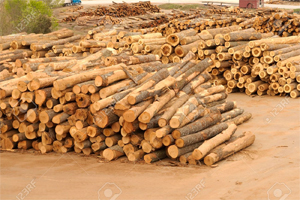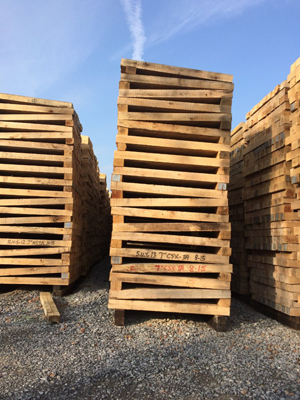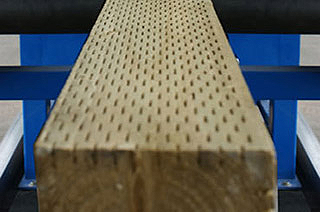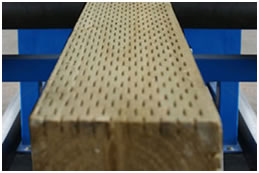Preparing Wood for Treatment
Structurally, wood is made up of cells of various sizes and shapes. In soft woods (generally conifers) long, thin cells lie parallel to the vertical axis of the trunk, the other cells lie across the trunk. The organization of cells in deciduous (usually hardwood trees) is more complex.
Cells in growing trees store water, food reserves, and extractives (resins, tannins, pigments, essential oils, fats, waxes, gums, and starches). Free water is inside the cells, bound water is held in the cell walls. Green wood from the forest contains a large amount of water. The high water content makes the wood attractive to wood destroying organisms and restricts the amount of preservative that it can absorb. The wood may not take up enough preservative to provide sufficient protection. If wood is treated wet, further drying can cause surface and end cracking. In general, green wood should be peeled and either seasoned or conditioned before the preservative is applied.

(photo: NHStateParks.org)
The moisture content (MC) of wood is usually expressed as a percentage of the weight of the wood after it has been oved-dried at about 216°F. The wood must be weighed accurately before and after drying.
%MC = (wet weight (before drying) - weight after drying) / weight of dry wood x 100
If fresh wood contains a large amount of water and the dry weight is less than half of the wet weight, then the MC is greater than 100%. The MC of fresh wood from living trees can range from about 30% to more than 200% based on weight. Timber or logs stored for long periods before processing can be protected from fungi and insects by submersion in pond water or by a continuous water spray. The water reduces the oxygen content and temperature of the logs to levels below those needed for pest development.
Much of the moisture in wood must be removed for most uses. Green lumber usually is seasoned or dried to:
- Prevent development of stain and decay organisms
- Reduce insect damage
- Control wood shrinkage
- Reduce weight and increase strength
- Prepare wood for chemical preservative treatments

(photo: 123RF.com)
Air-drying is a widely used, effective and inexpensive method of conditioning. Wood should be dried as quickly as possible; the time will vary, depending on climate, location and condition of the seasoning yard, methods of piling, season of the year, and size and species of the timbers. Drying offers some protection against wood-decaying organisms. Decay fungi do little damage to wood with a MC below 20%. They are most damaging at MC's from above 30% to saturation, which is too wet for favorable fungal growth. Bark obstructs penetration. In most cases, it should be peeled from wood products to enable quick drying. This also helps to avoid decay and insect damage and allows the preservative to penetrate the wood satisfactorily.

Air-drying rail ties (photo: Nisu Cellu-treat)
Air-drying yards and sheds should be located on well-drained sites with good air circulation. They should be kept free of weeds, debris, and rotted wood that retains moisture or provides a source of fungi or insects. The wood should be inspected often for such damage and handled carefully to prevent mechanical damage. Air-drying may not be effective under warm, wet climatic conditions because wood can absorb moisture from rain or from air that is excessively humid.
Kiln drying offers better control of air movement, temperature, and drying rate than does air-drying. It is quicker but more expensive so it is used for valuable materials.
Other methods for conditioning green wood materials include:
1). Steam and vacuum process - green wood is first steamed in a cylinder then subjected to a vacuum that removes the water in the wood by evaporation. The water is replaced by preservative applied under pressure.
2). Boulton process - creosote is introduced into a treatment cylinder at the same time that water is being removed under a vacuum. This process occurs at a lower temperature than the steam and vacuum process and is safer for some species of wood.
3). Vapor drying - green wood is exposed to an organic chemical such as xylene that gradually vaporizes and removes the water.
4). Incising creates a series of narrow 1/2 to 3/4 inch deep holes or slits in the wood to allow better penetration of preservatives.

Incised wood (photo: kopperspc.eu)
5). Cutting, shaping, or boring the wood for its intended use before preservatives are applied can prevent exposure of untreated surfaces that result if these processes are done after treatment.
[return]






